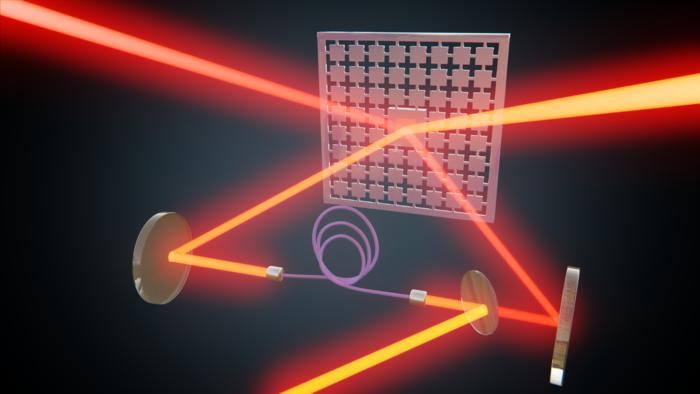Researchers at the University of Basel have developed a novel method that allows them to use only laser light to cool a small membrane to temperatures very close to absolute zero. Such intensely cooled membranes could, for example, be used in exceedingly sensitive sensors.

In the Basel experiment, a laser beam is directed onto a membrane (square in the middle). Using the reflected laser light, delayed by a fiber optic cable (violet), the membrane is then cooled down to less than a thousandth of a degree above absolute zero. Image Credit: University of Basel, Department of Physics
Johannes Kepler, a German astronomer, proposed the idea of solar sails 400 years ago, which could be used by ships to travel through space. He believed that when light is reflected by an object, a force is applied. He was also able to explain why comet tails point away from the sun using this idea.
Nowadays, atoms and other particles are slowed down and cooled using light force, among other things. A complicated apparatus is typically required for this.
Using just laser light, a team of researchers at the University of Basel has successfully cooled a wafer-thin membrane to a temperature near absolute zero, or minus 273.15 °C. The team was led by professors Dr. Philipp Treutlein and Dr. Patrick Potts. Their findings were just recently published in the scientific journal Physical Review X.
Feedback Without Measurement
What makes our method special is that we achieve this cooling effect without making any kind of measurement.
Maryse Ernzer, Study First Author and PhD Student, University of Basel
The laws of quantum mechanics dictate that measurements, which are frequently necessary for feedback loops, cause the quantum state to change and hence cause disturbances. To prevent this, researchers from Basel created a system known as a coherent feedback loop in which laser light serves as both a sensor and a damper.
They achieved this by dampening and cooling the thermal vibrations of a silicon nitrate membrane about half a millimeter in size.
The researchers aimed a laser beam onto the membrane and fed the light reflected by the membrane into a fiber optic cable in their experiment. The vibrations of the membrane generated small modifications in the oscillation phase of the reflected light during this operation.
The information contained in that oscillation phase on the immediate motional state of the membrane was then employed, with a time delay, to exert just the appropriate amount of force on the membrane at the right moment using the same laser light.
Ernzer added, “That is a bit like slowing down a swing by briefly touching the ground with one’s feet at the right time.”
The researchers used a 30-meter-long fiber optic cable to achieve the optimal latency of roughly 100 nanoseconds.
Close to Absolute Zero
Professor Potts and his collaborators developed a theoretical description of the new technique and calculated the settings for which we could expect to achieve the lowest temperatures; that was then confirmed by the experiment.
Dr. Manel Bosch Aguilera, Postdoctoral Researcher, University of Basel
The membrane was cooled by him and his colleagues to 480 micro-Kelvin or less than a thousandth of a degree above absolute zero.
The next stage will involve refining the experiment to the point when the membrane achieves the quantum mechanical ground state of its oscillations, which is the lowest temperature that can be achieved. The creation of so-called squeezed states of the membrane should then be conceivable.
Due to their ability to increase measurement precision, such states are particularly intriguing for sensor construction. Atomic force microscopes, which are used to scan surfaces with nanometer resolution, are one potential application for such sensors.
Journal Reference:
Ernzer, M., et al. (2023) Optical Coherent Feedback Control of a Mechanical Oscillator. Physical Review X. doi:10.1103/PhysRevX.13.021023.